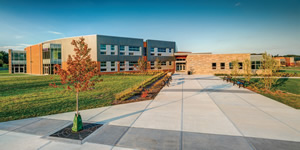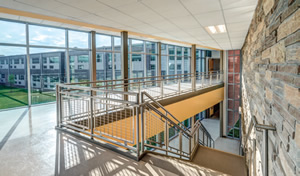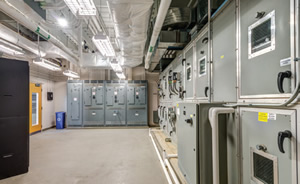Reaping Numerous Benefits
- By Jeff Parker, Jim Messner
- 08/01/14

PHOTOS COURTESY OF SHP LEADING DESIGN
Sustainability is a term used frequently in school design and construction, and for good reason. As school districts explore every option to stretch limited funds, sustainability should be an important part of the discussion. Energy costs are trending upward, and utilities comprise an increasingly significant portion of operating budgets for many districts.
But what does sustainability really mean for school facilities? At SHP Leading Design, we view sustainability as something our clients can perpetuate — something that will enable them to continue to operate their buildings as intended with the resources they possess. Yes, it means being more eco-friendly but perhaps more importantly, it means being as highly efficient as possible while creating an environment conducive to learning.
Sustainability offers a number of tangible benefits for both renovations and newbuild projects, as evidenced by the Beavercreek School District outside Dayton, Ohio. The district recently built two new schools (elementary and middle) and upgraded six existing schools with new HVAC and lighting systems and other improvements. In the process, Beavercreek earned the largest energy rebate in the history of Dayton Power & Light (DP&L) — $578,819 — while realizing annual energy savings that totaled hundreds of thousands of dollars.
In our collaboration with Beavercreek Schools, we employed several strategic practices for enhancing efficiency and earning energy rebates. Here are our top seven.
Identify your values and priorities
When we started the design process, we asked the district what was most important to them. In addition to improving academic performance, they told us energy was a top priority. Al Nels, president of the Beavercreek Board of Education, explained it this way:
“We entered into our renovation and construction projects with two priorities where energy was concerned: to be as efficient as possible in terms of our consumption, and to ensure that our choices related to energy were in the best interests of our taxpayers,” he says. “We consulted with our utility early in the process to learn about their rebate program, and worked closely with SHP, our design firm, to ensure that our priorities were addressed during the planning and implementation phases. This collaboration and forethought was critical to the success of our projects.”

PHOTOS COURTESY OF SHP LEADING DESIGN
It’s Natural. Beavercreek School District, located near Dayton, Ohio, with the help of SHP Leading Design, combined the middle and elementary schools on one campus, each with its own separate entrance. Among the sustainable features of the combined facility are the large windows that allow for daylight harvesting and smart lighting.
As Nels asserts, identifying these values up front allowed us to focus on what it would require to deliver them, and to make sure we had the necessary discussions and performed our due diligence to devise the best approach. Through life cycle cost analysis, energy performance goal setting and other investigation, we realized that with a modest three-percent budget increase for the two new schools, we could deliver everything the district sought in facilities infrastructure and energy efficiency, including a geothermal heating and cooling system — all with the realistic expectation that the initial extra costs would be recaptured on the back end. Doing this at the beginning of the process also enabled the district to increase their total bond fund request before it was put before and ultimately approved by Beavercreek voters.
Take a holistic approach
In the quest for energy efficiency, it’s easy enough to lose sight of the fact that a holistic approach to building design is required for educational facilities. Realizing that every aspect of a building’s design — from how it’s laid out to comfort level, acoustics, lighting and indoor air quality — have a very real impact on a student’s ability to learn. Making a building more energy efficient can free up funds for hiring additional staff or purchasing new equipment that can boost academic performance. Sustainability is a worthy pursuit in and of itself but it’s even better when it positively impacts the lives of the people using the building.
Perform energy modeling and revisit it often
Energy modeling involves a thorough analysis of the site design, projected daily energy requirements and utility rates that produces the estimated total cost to operate the building each year. Having this concrete data is essential to good decision making and is critical to the success of any sustainable project. It can be used to make detailed comparisons of various systems under consideration, and it leads to fact-based decision making as a project unfolds and construction managers seek ways to cut costs.

PHOTOS COURTESY OF SHP LEADING DESIGN
Money machines? The combined mechanical equipment, being used by Beavercreek School District, located near Dayton, Ohio, helped them earn the largest energy rebate in the history of Dayton Power & Light (DP&L) — $578,819 — while realizing annual energy savings that totaled hundreds of thousands of dollars.
Energy modeling of the new Coy Middle School/Trebein Elementary School campus, for example, clearly illustrated why aggressive daylight harvesting, more efficient lighting fixtures and control systems and a geothermal HVAC system were smart investments that would pay for themselves through substantial energy usage savings. (For more information on the Coy/Trebein campus project, see sidebar).
The renovations presented a different challenge; because many of the existing buildings were not air conditioned, the owner was concerned about the increased utility costs. To address these concerns, a detailed system analysis was completed to select the best systems for the existing buildings. This system analysis included a detailed review of all system costs, including installation, utility and life cycle operation and maintenance, that aided in the selection of new, high-efficiency lighting and simpler HVAC (with high-efficiency condensing boilers, variable speed pumps and efficient air-cooled chiller) and advanced temperature controls to optimize the systems. Once installed and operating, these improvements with fully air-conditioned buildings actually use less energy than before the improvements (when buildings were heated only).
The earlier energy modeling is undertaken in a project, the greater the benefits. For maximum benefit, revisit assessments often, especially when changes are being considered, in order to align the entire design and construction team on the benefits and drawbacks of field changes.
Engage your local energy utility early
We have found that every energy utility company has a different set of rebate requirements and processes, so it’s wise to engage your energy provider early in the project. By doing so with DP&L, we were able to keep our eyes on the rebate prize during building and systems design and make decisions we knew they would view favorably. DP&L also graciously offered their insights on various HVAC systems we were considering for retrofitting the six existing buildings. When it comes to obtaining energy rebates, it’s interesting to note that while LEED certification is not necessarily a requirement for rebates, energy modeling is typically required to apply for the larger rebates, as it clearly states your case on initiatives you’ve undertaken to be energy efficient and what the end result will be.
Consult those in the know
As we began work to upgrade the HVAC, lighting and electrical systems of Beavercreek’s six existing schools, we spent a lot of time consulting with the facilities management teams that are tasked with operating these buildings, some of which date back to the 1920s. These are the hands-on, day-to-day facilities pros who intimately know the strengths and flaws of their buildings, and their input to the design process was invaluable.
Seek economies of scale
While it’s not always feasible to combine two schools on one campus as we did on the Coy/Trebein project, we realized tremendous economies of scale savings by doing so (see the sidebar for more details). While still achieving the district’s need to give the schools separate identities, we were able to save construction costs and enhance efficiency by sharing a geothermal system, sanitary and water taps, electrical systems, kitchen and other key infrastructure components. By standardizing the HVAC systems in the six existing buildings, we were able to simplify maintenance by preventing the district’s facilities management team from having to master the nuances of different systems.
Keep the relationship intact after project completion
SHP continues to monitor the systems we put in place to ensure they are performing as designed. Today’s sophisticated HVAC, lighting and other building systems can be thrown off from their peak performance with even slight adjustments so it’s important to maintain a relationship with those who designed and installed them.
By utilizing all the technology and other tools we have at our disposal today, it is possible to create sustainable schools that can have a powerful impact on the lives of our children. It’s an exciting time to be an architect, engineer or design professional who has the privilege of working with educators.
This article originally appeared in the issue of .